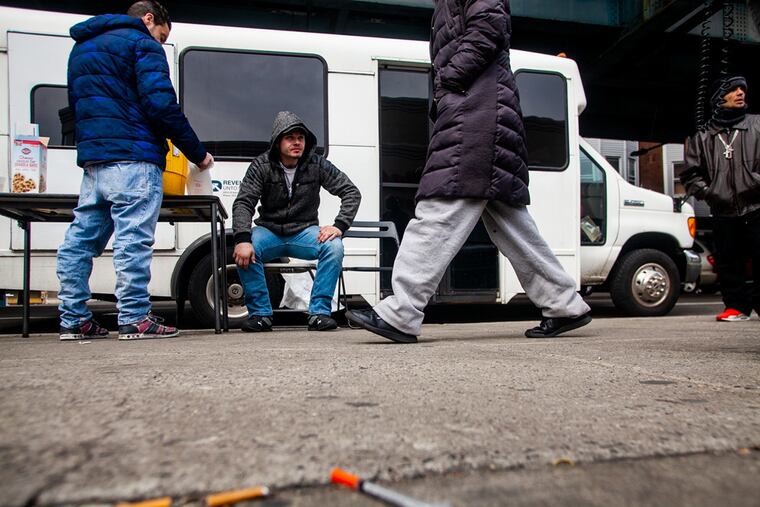Harm reduction saves lives now and in the future | Opinion
As an emergency physician, I've seen Philadelphia make great strides in using harm reduction to save and improve lives.

I am an emergency physician. I work daily to address emergencies and acute care needs for patients — some life-threatening, all deeply concerning.
The fundamental purpose of my job is to do everything I can to save a life in the immediate, while also trying to limit risks and increase access to ongoing services for patients once they leave my care. I do this knowing that my control and impact may not extend beyond the time and space of the Emergency Department.
In recent court proceedings, U.S. Attorney William McSwain questioned the purpose of saving a life today if that life could be at risk again tomorrow. His question addressed specific harm reduction methods related to overdose prevention sites, but essentially challenged a basic premise of emergency care and our mission within the medical system — every life is equally worth saving.
In my career, it took my looking beyond the world I knew best to understand that harm reduction offers solutions to support the city’s most vulnerable populations. A panel of local experts across disciplines presented evidence behind harm reduction approaches at the College of Physicians on Wednesday.
Harm reduction describes practical strategies and ideas to reduce negative consequences associated with high-risk behaviors, including drug use. Harm reduction efforts use cost-effective and evidence-based policies and programs in order to reduce health-related, social, and economic harms, such as communicable diseases, personal and community safety, and death. Prevention Point Philadelphia, a nationally renowned harm reduction organization in our city, was first sanctioned in 1991 in response to a burgeoning HIV/AIDS crisis and currently tracks 120,000 yearly client visits across its access points.
While the hallmark of harm reduction in the U.S. has been needle exchange programs, harm reductionists have worked in many realms and levels to mitigate the potential risks associated with substance use disorders. These strategies have included direct patient care, including medical screening and counseling, and influencing policy on local and national levels, like increased access to naloxone to prevent overdose.
Many harm reduction organizations in urban areas have evolved into broad-service public health organizations, conducting basic wound care, care coordination, primary care for infectious disease, and even emergency shelter and partnerships with housing-first programs, such as Pathways to Housing, that find permanent housing for those who are chronically homeless regardless of their drug use status.
Emergency Departments form an intersection between the medical system and the communities they serve. This vantage allows emergency physicians to act as observers of the strengths and limitations of our health system, watchdogs of population heath issues, and barometers of policy in action. This is perhaps no greater reflected than through the efforts of emergency physicians across the Philadelphia region to confront the opioid crisis.
The city’s network of Emergency Departments has developed innovative, patient-centered approaches to address the needs of those who come to our doors and to prevent morbidity and mortality beyond the hospital.
Emergency physician champions across the region — from Cooper University Hospital, Doylestown Hospital, Temple University Hospital, Methodist Hospital, and Penn Medicine — have made great strides in developing safeguards for opioid prescribing, working to reduce overdoses, streamlining access to treatment, and on the whole combating this public health crisis. Each of these efforts reflects harm reduction principles and philosophy.
Emergency physicians understand better than most that a step toward reducing negative outcomes is as important as taking a step toward a definitive cure. With heightened awareness of the consequences, we have engaged in more public health initiatives, such as the Emergency Opt-Out Program, an ED-based HIV screening program I developed at Jefferson, and Healing Hurt People, a program developed by Drs. Ted Corbin and John Rich at Drexel for victims coping with the ongoing trauma of intentional physical injury (such as from an assault).
In the words of Allan Clear, past executive director of the Harm Reduction Coalition, “we help people navigate systems that were designed to fail them.” So, too, feel many emergency physicians.
Harm reductionists and emergency physicians have realized that they could work together to best treat people who use drugs, reduce emergency visits, secure health homes (centralized spots for full-range medical care) and improve life outcomes. In the city of Philadelphia, we work as partners across the realms of education, leadership, advocacy, and policy. Our approaches may differ, but the mission is the same. All efforts are worth it to save a life.
Priya E. Mammen, M.D., MPH is an emergency physician and public health specialist. She is a fellow of the Lindy Institute of Urban Innovation and a trustee of the College of Physicians of Philadelphia, and sits on the board of directors of Pathways to Housing PA.